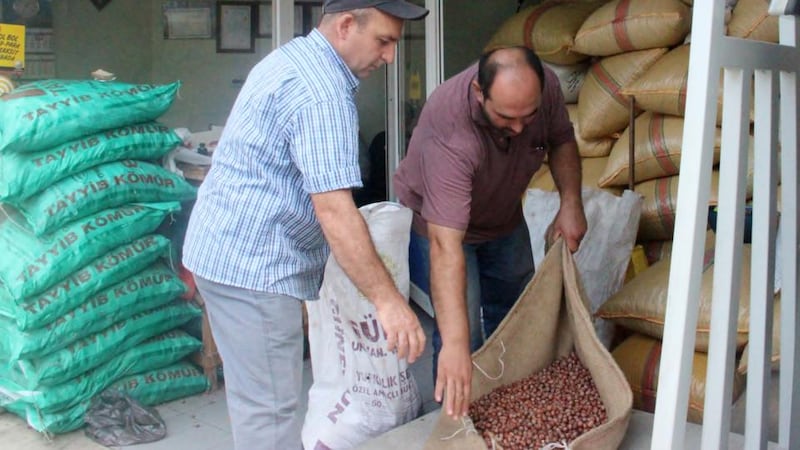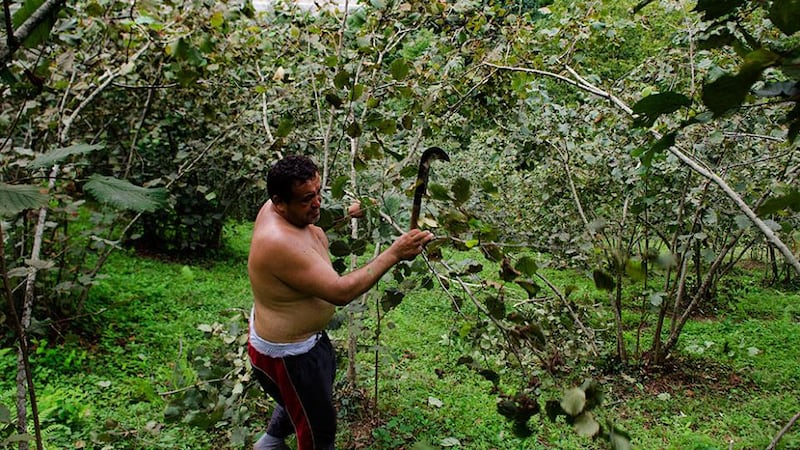The peaceful scene at the last harvest at ground zero of international hazelnut production – northeastern Turkey – belied a growing industry concern.
Falling supply following a severe frost 12 months ago has driven up the cost of hazelnut-based products in markets around the world.
Turkey’s hazelnuts are produced in a hilly region along the eastern Black Sea coast. About 700,000 hectares – almost the size of county Cork – are harvested every year.


But following a winter that saw the heaviest snowfall in decades, this month temperatures dropped to below freezing in many hazelnut-producing regions, raising fears of a repeat of last year’s stunted crop and inflated prices.
In a single day one nut-producing town experienced a 21 degree swing in temperature, something that does tremendous damage to early-growing trees.
Farmers working older trees or at high altitudes – hazelnuts grow poorly above 600m – are particularly susceptible to breaks in the weather. Producer Bahtiyar Kudu said that in 2013 local manufacturers offered him six lira (€2.15) a kilo but last year, because of the spring frost, that more than doubled.
“This local region is small; there are some hazelnut farms underneath the hills near the rivers. But the ones up the mountains froze [last March],” he said.
March’s frost snap
Farmers last year reported yields back 15 to 40 per cent, while a distributor in the coastal town of Gorele said 2014’s supplies to his distribution company were down 75 per cent on 2013. All attributed the decline to last March’s frost snap, and many fear a repeat scenario this summer following yet another severe winter.
Reflecting this concern, in February a kilo of double-roasted hazelnuts climbed to 100 Turkish lira (€36) when three years ago it stood at just 12 lira (€4).
With 350,000 tonnes produced last year Turkey is by far the world’s biggest exporter of the hazelnut, netting the economy €2.1 billion. The next biggest producers are Italy, the United States and Azerbaijan.
The global shelled hazelnut market was valued at €2.8 billion in 2013, with Turkey exporting to 106 countries. The prized nuts are used in making Nutella, Kinder chocolate and other well-known international food brands.
Confectionery producers turned to using hazelnuts in place of the more expensive cocoa after the second World War, and today nut-based products are acclaimed for their health benefits. But at 100 calories a tablespoon Nutella isn’t easy on the waist.
Unsurprisingly some interests are attempting to get ahead in a tightening market.
Italian Nutella producer Ferrero Group bought a large production company in Turkey with revenue valued at €370 million last July, and bought €750 million worth of hazelnuts from Turkey last year alone.
Turkey keeps 15 per cent of its total production for in-country consumption.
Local experts in Turkey were coy about how the 2015 harvest may yet play out. The Hazelnut Promotion Group said its members thought it too early to say – generally by June producers know how their August harvest is likely to pan out.
“This is known as supply-demand equilibrium and the hazelnut market will find its own balance…There is no chance for those [high] prices to continue like this,” the group told Turkey’s state news agency in February.
Ireland’s Nutella obsession
Turkey’s downsized hazelnut crop is likely to affect Irish consumers too. Thousands of jars of Nutella are consumed in Ireland every month to the tune of €4.3 million a year.
The Kinder Bueno chocolate bar, 10 per cent of which is derived from hazelnuts, is another big seller in Irish shops. Both are owned by Ferrero, which is now the fastest growing confectionery company in Ireland.
Millions of euro worth of hazelnuts are imported into Ireland in the form of confectionery goods. In addition to these prepared confections, Ireland imported €430,000 worth of dried and fresh hazelnuts between January and November last year. The nut is regularly used in salads, the production of cooking oil and in soups.
International market watchers now say they expect hazelnut supplies to run out before the 2015 crop becomes available for shipping next September or October.
"It looks like crops are not going to be particularly large again this year," said trader Adam Johnston of the Edinburgh-based Freeworld Trading company.
“The chatter I’ve heard so far is that anything over 500,000 tonnes [for Turkey’s total 2015 harvest] will probably see a decrease in the price, but at the moment it doesn’t look like it’s going to reach that,” he said.
And with Turkey’s lira losing 20 per cent of its value against the dollar over the last year, foreign currency reserves in the form of strong exports of the famed and fabled hazelnut have never been more critical to Turkey’s government.
Instead Turkey’s hazelnuts are looking like leaving a bitter taste in President Tayyip Erdogan’s mouth.








